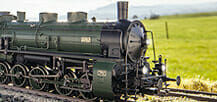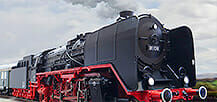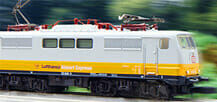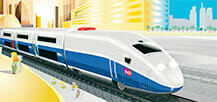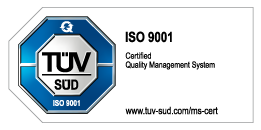Tank Locomotive.
Prototype: German State Railroad Company (DRG) Bavarian Group Administration class Gt 2x4/4 heavy freight locomotive. Version for the Transportation Exhibitions of 1924 in Seddin and 1925 in Munich.
Most Important Facts
| Article No. | 88290 |
|---|---|
| Gauge / Design type | Z / 1:220 |
| Era | I+II |
| Kind | Steam Locomotives |
Highlights
- Completely new tooling.
- All 8 axles powered.
- Prototype: Once the most powerful tank locomotive in Europe.
- Steel blue color scheme of the prototype at the Transportation Exhibitions of 1924/1925.
-
Product description
Model: Locomotive comes with a 5-pole motor. Both groups of driving axles pivot and all coupled driving axles are powered. Headlights are maintenance-free LED's. Minimum required radius for operation is 145 mm / 5-11/16". Length over buffers 81 mm / 3-3/16".
Find more Märklin explanation videos on our YouTube Channel
Spare parts for our articles can be found here in our spare parts search.
The 88290 tank locomotive is being produced in 2004 in a one-time series only for Insider members.
-
Publications
- New items brochure 2004 - Product programme 2005
-
Prototype information
All Wheel Drive with 8 x 8 When the first Bavarian Gt 2 x 4/4 locomotives were delivered in 1913, they were the most powerful steam locomotives of their time. Despite the low axle load and high maneuverability, they brought a previously unachievable tractive effort to the track. They mastered freight trains on steep Bavarian routes without helper engines, which accelerated traffic considerably and made it more economical. This was due to a Mallet design, whereby the front group of driving wheels was powered by high pressure cylinders and the back group was powered by low pressure cylinders. The back group of driving wheels was installed in a rigid frame; the front group could swing out. This allowed the locomotive to run on branch line curves. The first group of locomotives was followed in 1922 by a second group of 10 units, which were taken over by the DRG as the class 96. The latter group had design improvements to the cylinders and the boiler, which increased their power by 10 percent. The fuel bunker behind the engineer's cab was enlarged to increase the range of the locomotive's operation. The design changes and the standard DRG black paint scheme differentiated the class 96 considerably in looks from the first series.
